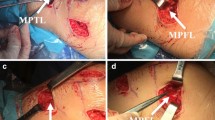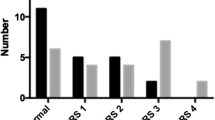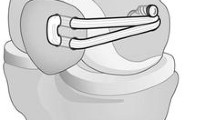Abstract
Purpose
To report outcomes after combined medial patellofemoral ligament (MPFL) and medial patellotibial ligament (MPTL) reconstruction and test associations between prognostic factors and clinical outcomes. It was hypothesised that combined MPFL and MPTL reconstruction would result in significant improvement in function, and that outcomes would be associated with age, sex, Beighton score, concomitant articular lesions, and preoperative function.
Methods
All combined reconstructions of MPFL and MPTL were reviewed. Inclusion criterion was minimum 2-year follow-up. Exclusion criteria were age at surgery ≥ 35 years and concomitant osteotomies. Kujala, Tegner and Marx scores were completed prospectively. Patients were evaluated at a minimum 2-year follow-up. Associations between potential prognostic factors and Kujala and Tegner scores were tested using bivariate analyses followed by multivariate regression models.
Results
Of 22 patients (26 knees), 19 (23 knees) met inclusion criteria, and 16 (20 knees) were available for follow-up. Mean age at surgery was 18 years (range 14.5–23). Mean follow-up was 43 months (range 24–73). Postoperative Kujala score significantly improved compared to before surgery (86.4 ± 12.5 vs. 54.9 ± 15.2, p < 0.01). Postoperative Tegner score was nonsignificantly higher compared to before surgery (4.8 ± 2.4 vs. 4 ± 3, p = ns) and lower compared to before first patella dislocation (4.8 ± 2.4 vs. 5.9 ± 1.2, p < 0.01). Postoperative Kujala score was associated with male sex (p = 0.02), with medial patellofemoral chondral lesions (p = 0.01) and with preoperative Kujala score (p = 0.05). Postoperative Tegner score was associated with male sex (p < 0.01), with preoperative Tegner level (p < 0.01), and with Beighton score (p < 0.01). Patella apprehension was recorded in two knees (10%) in two patients.
Conclusion
Combined MPFL and MPTL reconstruction in young adults results in significant improvement in subjective knee function with minimal risks, although preinjury activity levels are not consistently restored. Associated factors of improved outcome include higher preoperative knee scores and activity levels, medial patellofemoral chondral lesions, decreased Beighton scores, and male sex. This supports the advisability of the procedure and can also assist in setting realistic goals for specific groups of patients.
Level of evidence
Case series, Level IV.




Similar content being viewed by others
References
Anderson AF, Irrgang JJ, Kocher MS, Mann BJ, Harrast JJ, International Knee Documentation Committee (2006) The International Knee Documentation Committee subjective score evaluation form: normative data. Am J Sports Med 34:128–135
Baumann CA, Pratte EL, Sherman SL, Arendt EA, Hinckel BB (2018) Reconstruction of the medial patellotibial ligament results in favorable clinical outcomes: a systematic review. Knee Surg Sports Traumatol Arthrosc. https://doi.org/10.1007/s00167-018-4833-6
Beighton P, Horan F (1969) Orthopaedic aspects of the Ehlers–Danlos syndrome. J Bone Jt Surg Br 51:444–453
Brown GD, Ahmad CS (2008) Combined medial patellofemoral ligament and medial patellotibial ligament reconstruction in skeletally immature patients. J Knee Surg 21:328–332
Buckens CF, Saris DB (2010) Reconstruction of the medial patellofemoral ligament for treatment of patellofemoral instability. A systematic review. Am J Sports Med 38:181–188
Conlan T, Garth WP, Lemons JE (1993) Evaluation of the medial soft-tissue restraints of the extensor mechanism of the knee. J Bone Jt Surg Am 75:682–693
Drez D Jr, Edwards TB, Williams CS (2001) Results of medial patellofemoral ligament reconstruction in the treatment of patellar dislocation. Arthroscopy 17:298–306
Ebied AM, El-Kholy W (2012) Reconstruction of the medial patella-femoral and patello-tibial ligaments for treatment of patellar instability. Knee Surg Sports Traumatol Arthrosc 20:926–932
Giordano M, Falciglia F, Aulisa AG, Guzzanti V (2012) Patellar dislocation in skeletally immature patients: semitendinosus and gracilis augmentation for combined medial patellofemoral and medial patellotibial ligament reconstruction. Knee Surg Sports Traumatol Arthrosc 20:1594–1598
Hautamaa PV, Fithian DC, Kaufman KR, Daniel DM, Pohlmeyer AM (1998) Medial soft tissue restraints in lateral patellar instability and repair. Clin Orthop Relat Res 349:174–182
Hinckel BB, Gobbi RB, Demange MK, Bonadio MB, Pecora JR, Camanho GL (2016) Combined reconstruction of the medial patellofemoral ligament with quadricipital tendon and the medial patellotibial ligament with patellar tendon. Arthrosc Tech 5:e79–e84
Hinckel BB, Gobbi RG, Demange MK, Pereira CAM, Pecora JR, Natalino RJM, Miyahira L, Kubota BS, Camanho GL (2017) Medial patellofemoral ligament, medial patellotibial ligament, and medial patellofemoral ligament: anatomic, histologic, radiographic, and biomechanical study. Arthroscopy 33:1862–1873
Kaleka CC, Aihara LJ, Rogrigues A, de Medeiros SF, de Oliveira VM, de Paula Leite Cury R (2017) Cadaveric study of the secondary medial patellar estraints: patellotibial and patellomeniscal ligament. Knee Surg Sports Traumatol Arthrosc 25:144–151
Kikuchi S, Tajima G, Yan J, Kamei Y, Maruyama M, Sugawara A, Fujino K, Takeda S, Doita M (2017) Morphology of insertion sites on patellar side of medial patellofemoral ligament. Knee Surg Sports Traumatol Arthrosc 25:2488–2493
Kujala UM, Jaakkola LH, Koskinen SK, Taimela S, Hurme M, Nelimarkka O (1993) Scoring of patellofemoral disorders. Arthroscopy 9:159–163
Larson CM, Bedi A, Dietrich ME, Swaringen JC, Wulf CA, Rowley DM, Giveans MR (2017) Generalized hypermobility, knee hyperextension, and outcomes after anterior cruciate ligament reconstruction: prospective, case–control study with mean 6 years follow-up. Arthroscopy 10:1852–1858
Lippacher S, Dejour D, Elsharkawi M, Dornacher D, Ring C, Dreuhaupt J, Reichel H, Nelitz M (2012) Observer agreement of the Dejour classification of trochlear dysplasia: a comparison of true lateral radiographs and axial magnetic resonance images. Am J Sports Med 40:837–843
Lippacher S, Dreyhaupt J, Williams SR, Reichel H, Nelitz M (2014) Reconstruction of the medial patellofemoral ligament: clinical outcomes and return to sports. Am J Sports Med 42:1661–1668
Magnussen RA, Reinke EK, Huston LJ, Group MOON, Hewett TE, Spindler KP (2016) Effect of high-grade preoperative knee laxity on anterior cruciate ligament reconstruction outcomes. Am J Sports Med 44:3077–3082
Marx RG, Stump TJ, Jones EC, Wickiewicz TL, Warren RF (2001) Development and evaluation of an activity rating scale for disorders of the knee. Am J Sports Med 29:213–218
Nwachukwu BU, Chang B, Voleti PB, Berkanish P, Cohn MR, Altchek DW, Allen AA, Williams RJ, Rd (2017) Preoperative short form health survey score is predictive of return to play and minimal clinically important difference at a minimum 2-year follow-up after anterior cruciate ligament reconstruction. Am J Sports Med 45:2784–2790
Outerbridge RE (1961) The etiology of chondromalacia patella. J Bone Jt Surg 43:752–757
Parikh SN, Wall EJ (2011) Patellar fracture after medial patellofemoral ligament surgery: a report of 5 cases. J Bone Jt Surg Am 93:e97(1–8)
Philippot R, Boyer R, Testa R, Farizon F, Moyen B (2012) The role of the medial ligamentous structures on patellar tracking during knee flexion. Knee Surg Sports Traumatol Arthrosc 20:331–336
Philippot R, Chouteau J, Wegrzyn J, Testa R, Fessy MH, Moyen B (2009) Medial patellofemoral ligament anatomy: implications for its surgical reconstruction. Knee Surg Sports Traumatol Arthrosc 17:475–479
Schiphouwer L, Rood A, Tigchelaar S, Koeter S (2017) Complications of medial patellofemoral ligament reconstruction using two transverse patellar tunnels. Knee Surg Sports Traumatol Arthrosc 25:245–250
Schneider DK, Grawe B, Magnussen RA, Ceasar A, Parikh SN, Wall EJ, Colosimo AJ, Kaeding CC, Myer GD (2016) Outcomes after isolated medial patellofemoral ligament reconstruction for the treatment of recurrent lateral patellar dislocations: a systematic review and meta-analysis. Am J Sports Med 44:2993–3005
Senavongse W, Amis AA (2005) The effects of articular, retinacular, or muscular deficiencies on patellofemoral joint stability. J Bone Jt Surg Br 87:577–582
Shah JN, Howard JS, Flanigan DC, Brophy RH, Carey JL, Lattermann C (2012) A systematic review of complications and failures associated with medial patellofemoral ligament reconstruction for recurrent patellar dislocation. Am J Sports Med 40:1916–1923
Sobhy MH, Mahran MA, Kamel EM (2013) Midterm results of combined patellofemoral and patellotibial ligaments reconstruction in recurrent patellar dislocation. Eur J Orthop J Traumatol 23:465–470
Tegner Y, Lysholm J (1985) Rating systems in the evaluation of knee ligament injuries. Clin Orthop Relat Res 198:43–49
Zaffagnini S, Grassi A, Marcheggiani Muccioli GM, Leutzow WF, Vaccari V, Benzi A, Marcacci M (2014) Medial patellotibial ligament (MPTL) reconstruction for patellar instability. Knee Surg Sports Traumatol Arthrosc 22:2491–2498
Funding
This study did not receive any specific grant or any funding from any funding agency.
Author information
Authors and Affiliations
Corresponding author
Ethics declarations
Conflict of interest
The authors declare that they have no competing interests.
Ethical approval
The local Institutional Review Board (Meir General Hospital, Kfar Saba, Israel) approved the study protocol (I.D. 0216-13-MMC).
Rights and permissions
About this article
Cite this article
Hetsroni, I., Mann, G., Dolev, E. et al. Combined reconstruction of the medial patellofemoral and medial patellotibial ligaments: outcomes and prognostic factors. Knee Surg Sports Traumatol Arthrosc 27, 507–515 (2019). https://doi.org/10.1007/s00167-018-5145-6
Received:
Accepted:
Published:
Issue Date:
DOI: https://doi.org/10.1007/s00167-018-5145-6




